On May 20, 2012, a thirty-year-old man named Marlon Errol Hariram boarded a flight in Georgetown, Guyana, bound for New York City, with nine live finches, individually concealed in cardboard toilet paper rolls and hidden in the sleeves of a shirt he carried with him. The rolls were wrapped with netting and packing tape so that the birds would remain quiet throughout the flight. Hariram had no trouble boarding the plane: after being nabbed with finches at Georgetown’s Cheddi Jagan International Airport a few times in the past, he’d learned whom to pay off.
Upon arrival, the Department of Homeland Security referred Hariram for a customs examination, during which officers found the birds. When Special Agent Ryan Bessey of the U.S. Fish and Wildlife Service arrived on the scene, he recognized the birds as chestnut-bellied seed finches, scientifically classified Oryzoborus angolensis, and commonly known among Guyanese as towa towas. Hariram told Bessey that he had purchased the finches in Guyana for approximately $20 each, and that they could be sold easily in Queens.
The finches were sent to a U.S. Department of Agriculture quarantine facility, where seven of them died. Hariram was later arrested and indicted by a grand jury on three felony charges: violating the Lacey Act, smuggling illegal goods into the United States, and making a false statement on his customs declaration form. He pleaded guilty to all three counts.
Agent Bessey was familiar with Hariram. He had interviewed him in 2011, after Hariram was caught with five birds and fined $350. Bessey had also seen chestnut-bellied seed finches before. As he noted in his affidavit in support of Hariram’s arrest, customs and border patrol officers at New York’s JFK Airport have “intercepted numerous individuals trying to bring finches, which are small seed-eating birds, into the United States from Guyana by concealing the birds in various manners.” He continued:
My investigation has revealed that certain Guyanese immigrants living in the Eastern District of New York keep finches to enter them in singing contests. In such contests, often conducted in public areas like parks, two finches sing and a judge selects the bird determined to have the best voice… Although certain species of finch are available in the United States, species from Guyana are believed to sing better and are therefore more highly sought after. The resulting market for Guyanese finches in the New York area can translate into financial profit for someone willing to smuggle finches into the United States from Guyana.
Hariram’s finches were bound for Richmond Hill, Queens, where Guyanese flags flap from the windows of curry shops and bakeries along Liberty Avenue, and grocers sell cassava bread and jackfruit and bitter melons. There are some 140,000 Guyanese immigrants in New York City, and a sizable portion of them reside here.
Atlantic Avenue bisects the heart of the neighborhood, terminating at a massive open-air trainyard currently used by the Long Island Rail Road. Steam locomotives chugging through used to belch soot and ash that drifted down to a landing zone just south of the rail yard. In 1938, that land became a park, which nearby residents dubbed “Smokey Oval.” It is officially known now as Phil “Scooter” Rizzuto Park, after the World War II–era Yankees shortstop who grew up in the area. Many Guyanese in the neighborhood meet here on Sunday mornings for the singing competitions, an activity known as “bird racing.”
On a typical temperate April morning, Smokey Oval is buzzing with activity: groups of teenagers shoot hoops and slap handballs, adults read on park benches or play softball on the diamonds, kids draw in the dirt, stomp in the playground, and nap in strollers. A group of Sikhs gather for prayer near the park’s ovular center green, rimmed with colorful flowers. The sky above is a chemical blue, with white rumpled clouds sailing across it like galleons. At the south end of the park, along 95th Avenue, nine men carry birdcages made of wood and wire and blanketed with white cloths. The drape on one cage is made translucent by the sun. I watch a small bird inside darting darkly from perch to perch, like a shadow.
“In our country, everybody has these birds,” says one of the men, named Shivan. He has curly tufts of black hair and wears a Yankees sweatshirt. Like the others, he does not want to give his last name. “I’ll go the whole year without seeing these guys until the weather gets like this and they bring their birds out.”
“It’s just a guy thing,” adds another man, Ronny. “It doesn’t matter who wins.”
The rules of the races are simple: two competitors place their caged birds on a five-foot wooden pole with two nails on either side at the top. Competing birds are kept far apart prior to the race so that neither will be intimidated or begin to whistle before the race begins. A judge begins a countdown, at the end of which the competitors whisk away the cloth drapes from the cages, revealing the minuscule finches inside. The birds, always male, begin whistling at each other, an aggressive display that is partly instinctual, and partly the result of training. Some are so pugnacious that they attempt to attack their opponent, flying from their perches to beat their wings against the cage’s bars. Counters tally the whistles, or “rackles.” The first bird to 50 is the winner.
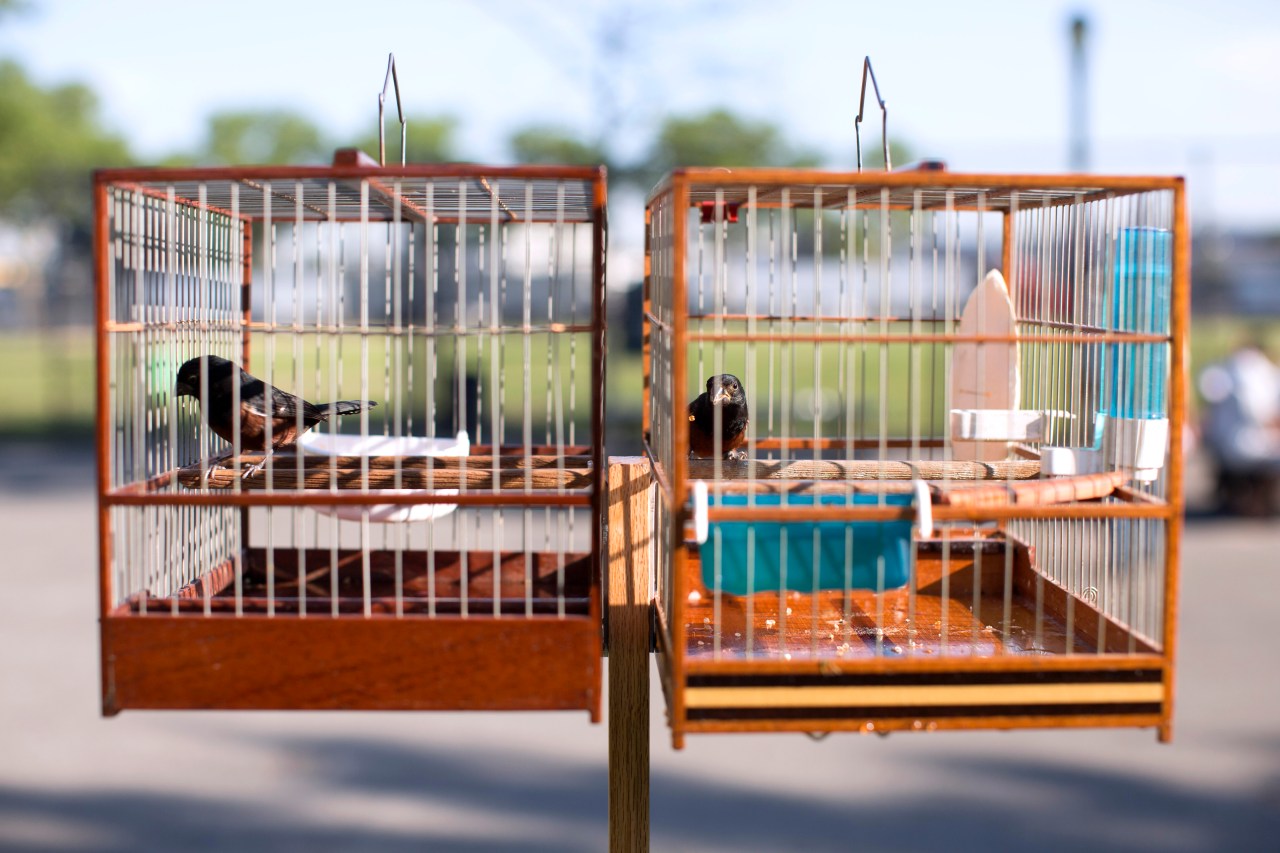
There are two species principally used in the races—the large-billed seed finch (oryzoborus crassirostris, called twa twa in Guyana) and its close relative, the chestnut-bellied seed finch, or towa towa, the species Hariram was carrying. Both species are in the tanager family, native to tropical and subtropical South America. The towa towa is by far the more common species; “due to its relative scarcity and purportedly finer song, the twa twa is nearly extinct in Guyana and Suriname,” Brian O’Shea, the ornithology collections manager for the North Carolina Museum of Natural Sciences, told me. Towa towas are small black birds that could fit in the palm of a child’s hand. The adult males sport a plump, tawny breast that gives the species its common name. Bets and side-bets are often placed on races by owners and bystanders, which makes a good whistling bird very valuable to its owner. Birding competitors, interested bystanders, and scouts attend, sometimes looking to buy the best birds. Gatherings of up to a hundred men are typical for the biggest races.
Despite increased media coverage, a recent crackdown by federal investigators, and the threat of fines and even jail time, local demand for the chestnut-bellied seed finch has not abated. If anything, the increased attention has impelled the smuggling operation to professionalize and diversify. Some adroit smugglers are now paid enough that they can run birds full-time, and some enterprising birdmen have begun breeding the finches at home in New York. One bird minder told me that a breeder he works with, in Jamaica, Queens, once paid $8,000 for a single, particularly talented specimen, just to obtain the bloodline. I tried calling the breeder several times, but after a few vague promises to meet up “later,” he stopped answering my calls altogether.
The towa towa’s song is not the long, lilting coo of other tropical songbirds; rather, the finches emit a series of rapid-fire whistles and aggressive squeaks, strung together like beads on a wire. The wild ones have a chittering, mellifluous clarion, a zreeet zreeet whistle that bird minders attempt to shorten, via training, for the races.
“These birds are very territorial when they see another male,” says Cullen Hanks, a biologist with the Texas Natural Diversity Database. “They sing, and that’s how they sort it out. Usually one will dominate and the other will submit. It’s really kind of a macho thing.” A strongly built ponytailed man in his thirties, Hanks is one of the world’s foremost experts on the transnational songbird economy.
Over breakfast one morning in Austin, Hanks tells me that the trade isn’t limited to Guyana—it’s widespread in Brazil and Suriname, as well. “What you have is a bird that’s actually pretty common,” he says. “They get around, colonize areas. But there are areas where they’re being wiped out by this trade, and you can kinda see the pattern: the coastal populations, where there are more people, have been wiped out, and people are going further and further in. Then the price goes up.”
There are financial and sporting imperatives to capturing the birds while they are still young. Before molting, young male chestnut-bellied seed finches are uniformly brown, identical to the females. These birds are called “bastards.” And these young finches, Hanks says, learn a song in the wild that is much longer than the song of prizewinning competitive finches. “The trapped birds are like raw material—the real value comes with the training. The birds will learn from the songs around them. So what they’ll do is catch a young bird and play a CD over and over and over again, to make sure the bird hears that short song.”
When a bird wins a big bet, and then another, and another, it gets a name that transcends that of its owner and becomes a star among bird-racing enthusiasts. The most valuable birds sell for more than $5,000 in the U.S. “People will pay more for a bird that wins competitions,” Hanks says. “So sometimes you place big bets not just to win those bets but to raise the value of the bird.” When scouts for richer North American buyers attend competitions, looking for talent, the bets go up. “For some people, their career is just churning out these birds.”
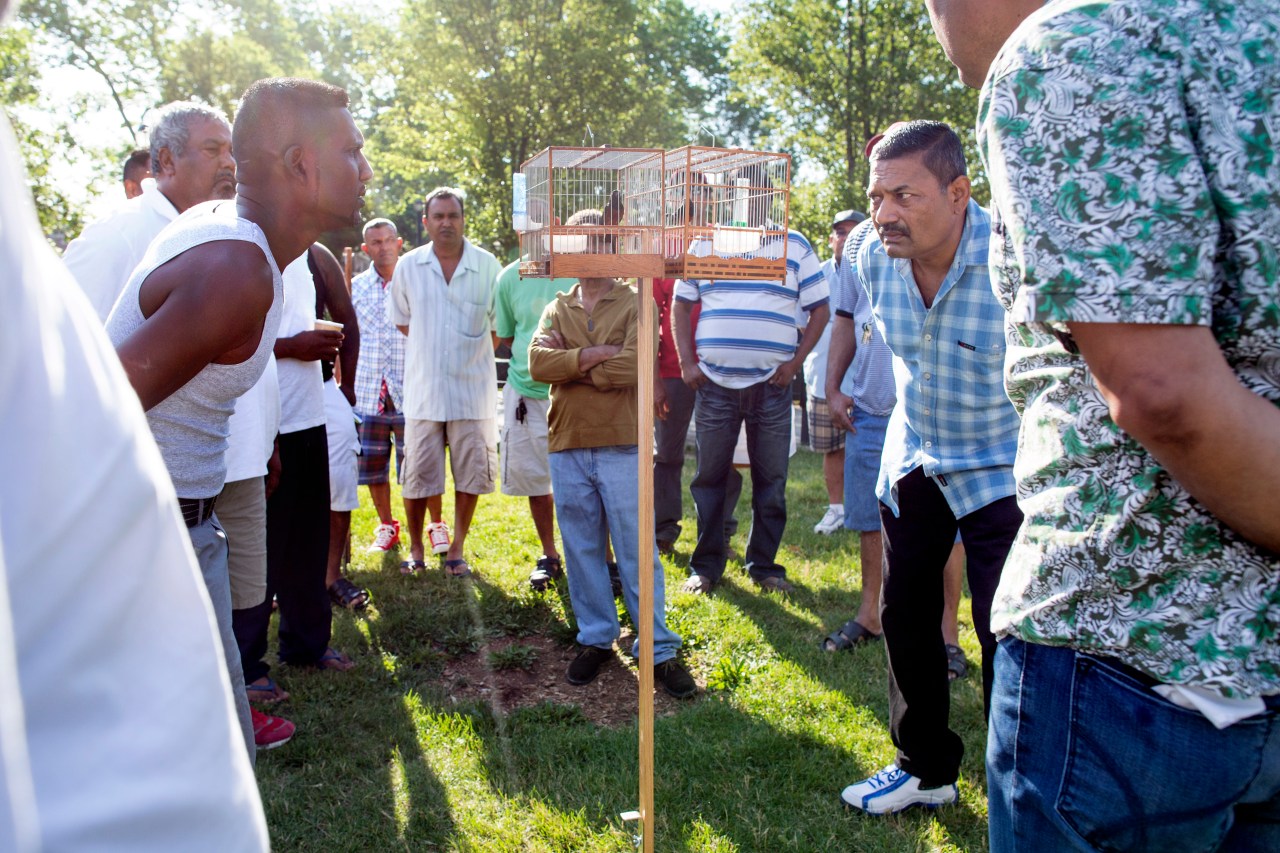
In New York, the Fish and Wildlife Service monitors a lot of international movement of live birds. In the early 2000s, customs agents began finding finches concealed in increasingly imaginative ways: swaddled in socks; zipped into hidden pockets and luggage linings; straitjacketed into hair curlers and toilet paper rolls, their wings pressed to their sides. Some had been sedated with rum, another Guyanese export. Their conveyors were men who intended to sell the birds that survived the abattoir of intercontinental transit (many did not) for sums sometimes in excess of $5,000 per bird, according to Agent Bessey’s affidavit for Hariram. To figure out just what, exactly, was going on, in 2006 the Fish and Wildlife Service’s Office of Law Enforcement embarked upon Operation G-Bird, an investigation focused on the smuggling of finches from South America, which wrapped up in 2014. Some 150 finches were confiscated by agents during the investigation. Oftentimes the giveaway was non-avian in nature: a poorly concealed package of bird seed, or a particularly skittish passenger.
The chestnut-bellied seed finch is not an endangered species, but it is regulated by Guyanese law, which means exporting it from the country requires it to be declared as a pet and the approval of a veterinarian. It’s an expensive, paperwork-intensive process. And because the USDA has listed Guyanese birds as potential carriers of Newcastle disease, any that come into the United States must be quarantined for 30 days, a stressful process—for the birds—that smugglers say affects their ability to perform. Newcastle disease is a contagious avian virus that afflicts the nervous and respiratory systems of birds; the most noticeable symptom is the twisting of the neck and head, resulting in paralysis. Domestic poultry are particularly susceptible.
“They don’t want them to go to quarantine—that’s the key,” another Fish and Wildlife Service agent tells me. “If you send them to quarantine, according to them, they don’t sing as good—because they’re around other birds, or something like that. It’s baloney. There’s no proof.”
Assessing black-market value is, of course, something less than a science. According to Bessey, the $5,000 figure quoted in his affidavit was a number the Fish and Wildlife Service consistently came across via sources or internet message forums. “We can’t turn to Amazon to see what these are being offered for,” he says.
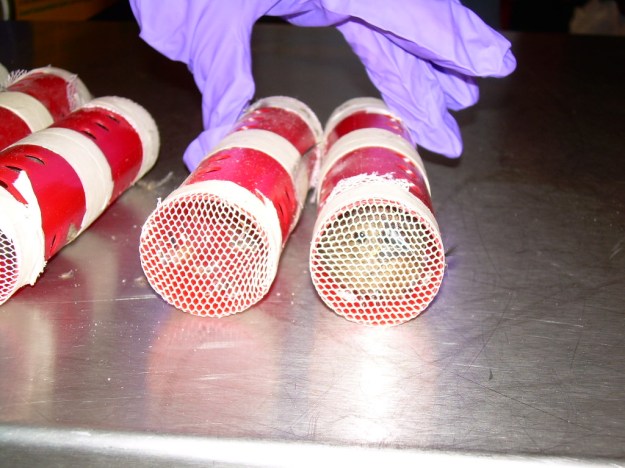
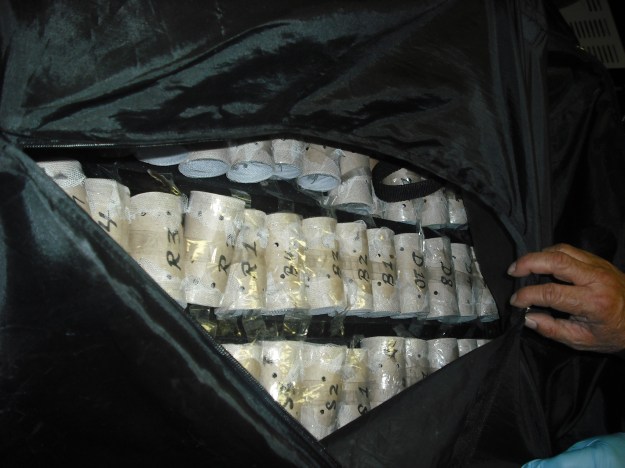
Following his trial in New York, Hariram was sentenced to six months in prison and two years’ probation. He served his time at Fort Dix Federal Correctional Institution, in New Jersey, the largest federal prison in America. I first made contact with him there. For his two prior arrests, he had been slapped with a fine. Because of this, he told me, he “did not know the [true] consequence of trying to import” the birds. “There’s bigger stuff to worry about than some finches,” he says. “They’re just some birds. We got birds here, flying all around.”
One day not long after Hariram was released, I meet him at the food court in the Journal Square PATH train station, in Jersey City. Hariram was born in Guyana but is a naturalized U.S. citizen, and at the time he was living with his mother in New Jersey. Hariram is tall and soft-spoken; these days, he works in general construction.
By his estimation, Hariram made hundreds of trips carrying birds, beginning in 2000. “You buy one from the pet store for, like, $20 down there, and you keep it and train it, meaning that you got CDs with a certain sound. You put it on and they will adopt that sound,” he says. “Then you give them the right feed, take them for a walk, socialize them, and they become high standard within a few months. Then you can sell them for like 300 to 500 dollars back home. Then when you bring it here, if it’s in good quality, these guys make thousands selling them. They gamble. But they make the arrangements beforehand.”
However, Hariram says most of the birds he brought back were for personal use. “Early in the morning, they’ll start to sing and fill the house with chirps. These are birds with a special chirp.” His relatives in New Jersey and Queens “want to hear those chirps,” he says, “like they do back home.”
Hariram reminisces frequently about Guyana—his wife and two young children, whom he hadn’t seen in two years, still live there. “This is like a punishment, being in this New York weather—the cold, and in the summertime it’s so hot. Back home it’s like 75 degrees year-round. It’s a holiday every day.”
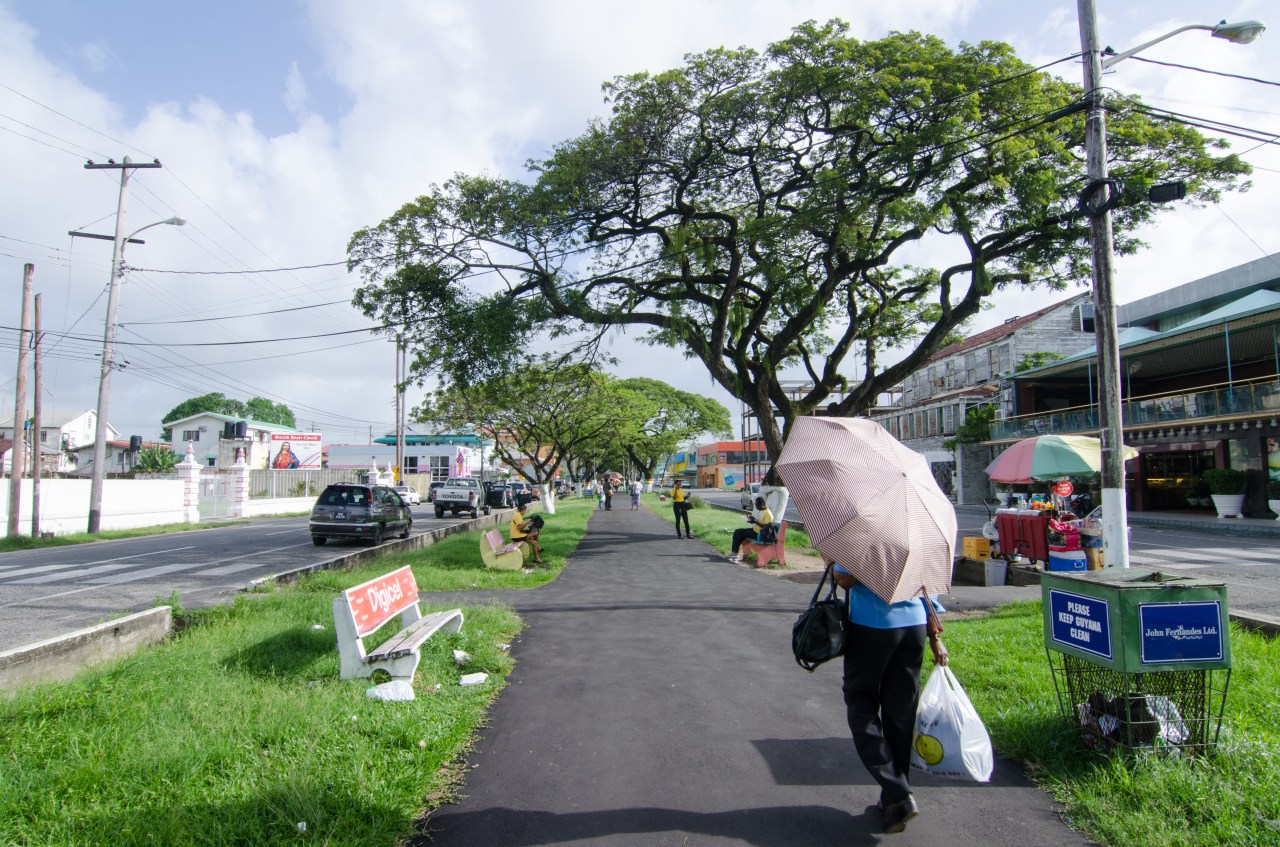
Guyana is often translated as “land of many waters,” but it’s also a land of many peoples—six races, as the national story has it: Indians, Africans, Portuguese, Chinese, Europeans, and aboriginal peoples, or Amerindians. All but the Amerindians came from distant lands, and none constitutes a majority. Guyana’s multiethnic populace is one reason why the country actually does have an inordinate number of holidays. The second day I was in Georgetown was Labor Day; four days later was Arrival Day, commemorating the first arrival of Indians to the country, 176 years earlier, to work as indentured servants for the British.
For many centuries Guyana, like most of the rest of the Caribbean, was valued primarily for the wealth it yielded to white Europeans. The Dutch were the first to settle the country, establishing three colonies named after the three main rivers running through the land—Essequibo, Demerara, and Berbice. They most likely brought over the first slaves from Africa. Throughout the eighteenth century, the Dutch colonies were lost and regained in skirmishes with the British, who finally established permanent control in 1814. They renamed the capital Georgetown, and unified the three colonies into British Guiana. The country remained under British control until independence, in 1966.
The oldest structure in Georgetown is Stabroek Market, a huge iron and steel building topped by a Victorian-era clock tower and housing a bustling bazaar. It covers an area of about 80,000 square feet, in which vendors sell meat, clothing, fabrics, electronics, jewelry, fruits, and vegetables. Within seconds of walking inside, you are bombarded by smells: fowl, fish, incense, the salt-laden air. The marketplace swallows the light; as you walk along the mazy aisles to the center, it gets darker, at least until you reach the other side, where speedboats bob in the brackish Demerara River. They charge 100 Guyanese dollars, or about 50 cents, to take you to the other side.
I’d come to Guyana with a couple of leads, but it seemed like everyone I met minded birds, or knew a guy who did. One of Georgetown’s many self-employed taxi drivers told me to come to the market to find bird sellers. I found just one—a gruff, weather-beaten man in an orange tank top. He had hung wooden cages from hooks in a small side alley of the marketplace.
He didn’t have any towa towas, but only because the trappers he works with hadn’t brought any. He buys birds from them for 6,000 Guyanese dollars, or about $30. Their quality is judged by their “passion,” he tells me—“How much they whistlin’, how aggressive they are.”
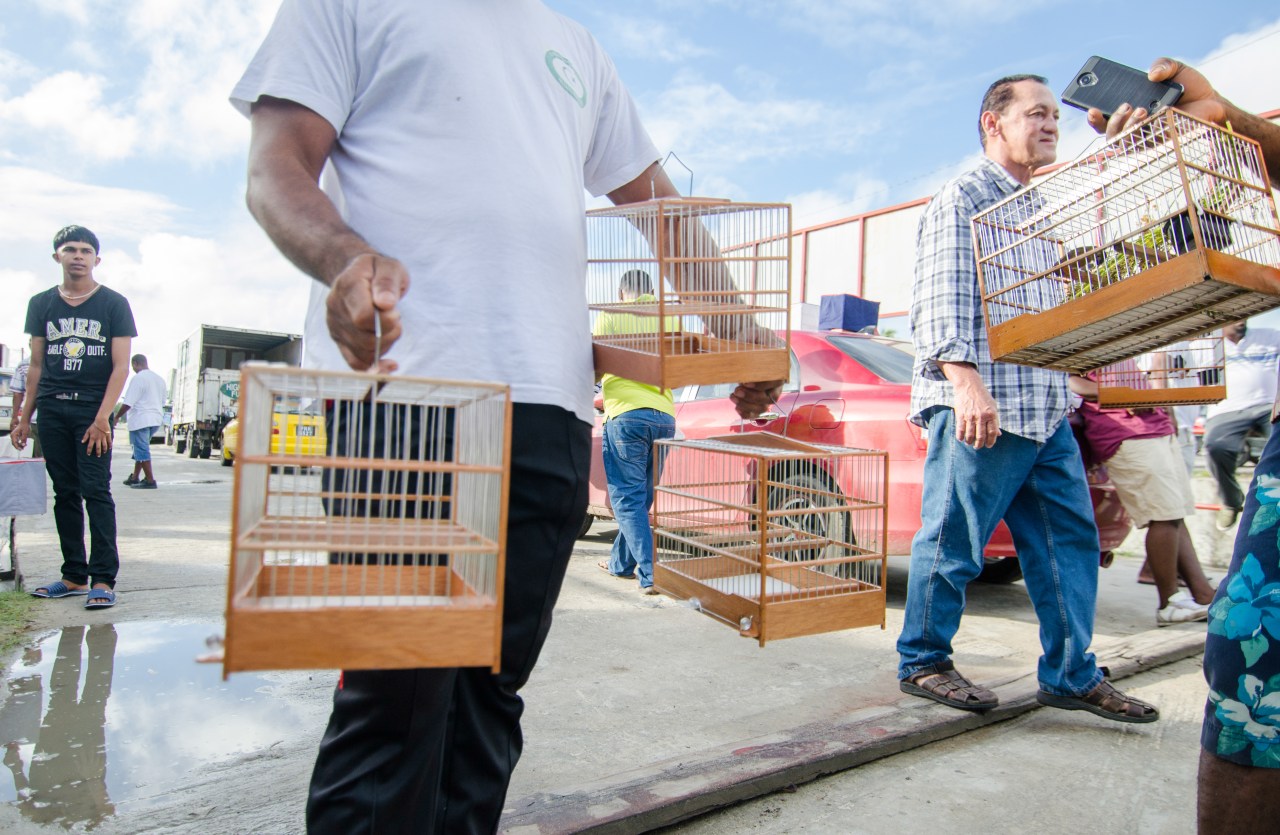
To catch the birds, trappers venture into mangrove forests and the savannah bush of Guyana’s interior, using caged finches as a lure to attract territorial males. The trappers will prime tree limbs with a sticky gum and net the wild finches when they alight on a limb. The trapper will then sell the wild birds to a middleman, who, in turn, sell to market vendors, retailers, or avid birders. “Sometimes people raise and train them and then sell them,” says Aiesha Williams, a biodiversity officer for the World Wildlife Fund’s Guyana office. “Some [bird minders] train a lot of them, keep them, maintain them for a few months, get them going, and sell them at a higher price.”
Michel Pereira is one such trainer. One afternoon I meet him at a bar across the street from the guesthouse in which I’m staying. Pereira is a dentistry student at the University of Guyana and, by unofficial account, one of the best bird trainers in the country. He uses some of the money he makes selling birds to fund his schooling. That morning, he’d returned from an expedition to the Berbice region.
The young wild finches “come with the bush whistle,” Pereira says. “So you train them—you either use a CD or an experienced bird that has a clean rackle”—an assistant coach of sorts. “If the bird pick up the whistle when he’s brown, the whistle stays with it. For the black bird it’s hard to catch the whistle. They’re rare. You got to go into the mountains or way down in the bush to get the towa towa.”
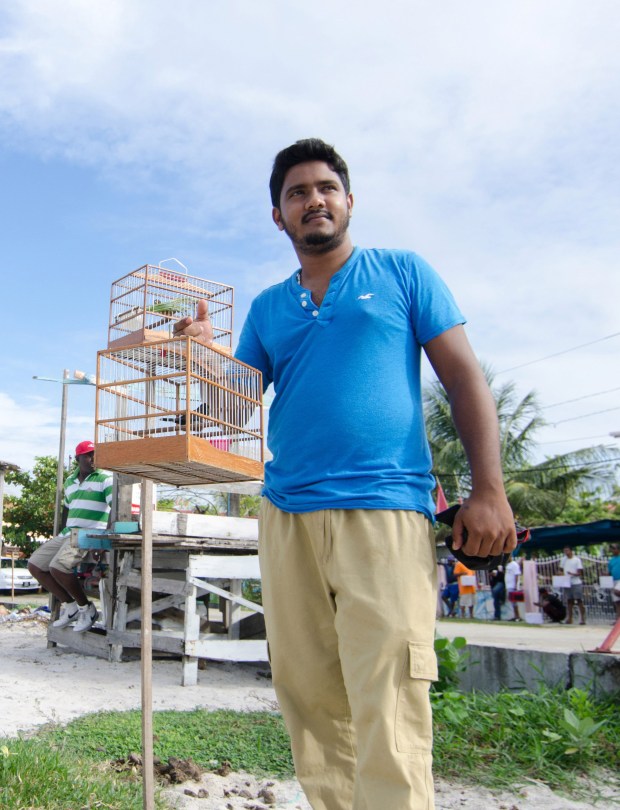
Pereira showed me a video of one of his best birds singing. “This is the clean whistle,” he says. “‘Peep-peow,’ they call it. The towa towa is the best bird for picking it up.” The black bird in the video stands erect on its perch, its burgundy chest thrust skyward, the song emanating effortlessly from its throat: pee-ee-ee-peow-peow-peow-peow.
To acclimate the birds to captivity, trainers “walk” them in public, socialize them with other birds, and expose them to larger animals, like horses and dogs. This creates a fearless, more aggressive bird that will show no mercy to timid opponents.
“From the time you start walking the bird and tame them, the price goes up,” Pereira says. “Once the bird is a good bird, and he big and whistling fast, the price goes to hundreds of thousands [of Guyanese dollars]. So that’s why people so serious about the bird: it’s a lot of time. It’s a good investment. And you care for them a lot: every day, people buy fresh green seed, the kind they eat in the bush, to give them. It’s a lot to put behind these birds. Some men treat their birds better than their wife and family.”
Pereira’s father used to mind birds, and his uncle, too, for 40, maybe 50 years. “I was born into the bird thing,” he says. His first bird wasn’t a towa towa, but he got it to catch the peep-peow anyway. When Pereira was an undergrad, he took an ornithology class to learn how to better care for finches. He sometimes studies with a bird on his desk. “I’m a bird man,” he says, “so when I hear that whistle, it’s nice.”
On Labor Day, I take a car along the coastal highway into the East Coast region, outside Georgetown. More than 90 percent of Guyana’s population lives along the agriculturally rich coastal plains; south of that, in the country’s interior, you’ll find some of the most pristine forest in the world. Beyond that are the rolling savannas of the Rupununi, choked with sedge and dotted with sandpaper and cashew trees. Beyond that is the serpentine Brazilian border.
I’m meeting Desh, a portly bird seller from whom Marlon Hariram frequently purchased finches. I find him in a sandy clearing along the side of the highway, selling birds and feed from the back of a blue pickup truck.
Desh has been dealing for 12 years. “Me buy them, no catch them,” he says. “I buy wild, train them up. You feed bird, mind bird, sell bird. It’s a moneymaking thing.” He abjures gambling, calling it a “loser’s game.”
We’re interrupted by a buyer, a middle-aged Indian man. Desh charges him 8,000 Guyanese dollars for a mature black bird and a sack of seed.
While the birds sell for much more in New York, the risks incurred by trafficking them aren’t worth it to Desh. After the transaction is complete, he asks me about Hariram: how’s he doing; how’s his family? “Selling birds, you got to be careful, do you understand?” he says. “You smuggle it, you lose, not me. You take a chance.”
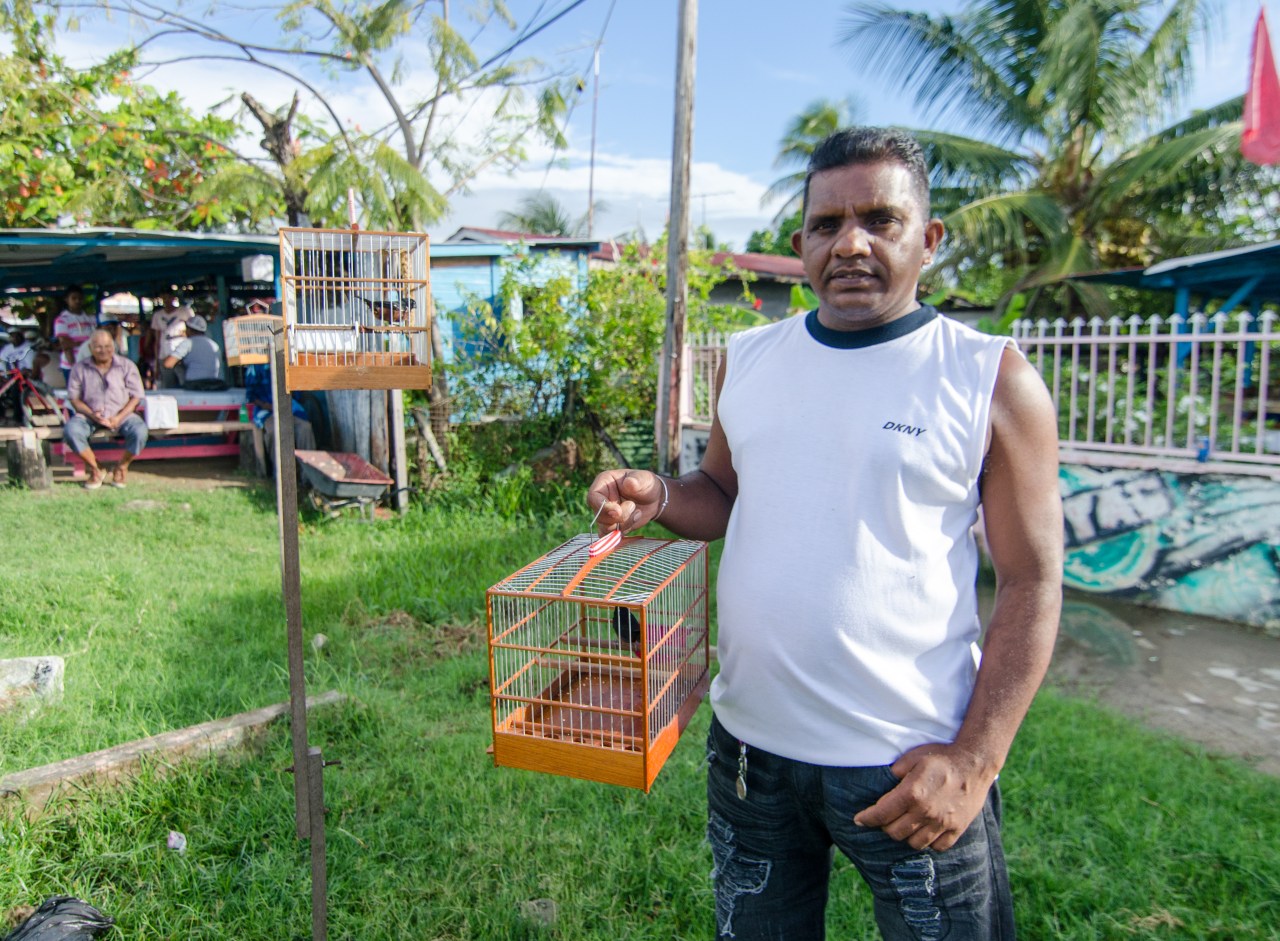
Afterward, I head to the home of man named Sodash, one of Hariram’s friends and a fervent birder. He’s 25 years old and works as a painter. Tattoos crawl up his arms and neck. Sodash owns two towa towas. One of them has recently been molting, and isn’t in the best condition. The other is a very strong bird, with a plume on the back of his neck, which gave him his name: Hot Skull. Sodash bought Hot Skull in “good condition,” meaning he had already been trained. “He whistles like a CD,” Sodash says. He paid $600 for the bird.
Sodash lives with his wife, mother, grandmother, and younger siblings in a ramshackle house typical of the area. When I arrive, most everyone was lounging in hammocks or sitting in front of oscillating fans on the concrete porch out back, drinking soursop juice and Coca-Cola. The kids ran around for a while before heading inside, where it was marginally cooler.
Every Sunday, Sodash goes to a bird race that takes place in a nearby ditch off the East Coast highway. He estimates he’s kept about 40 birds since he was 15, when he received his first songbird as a gift from his grandfather. He observes that bird-minding is becoming more popular. “Lots of people minding birds right now,” he tells me. “You go to any park in the country on Sunday, and you’ll see birds.” Sodash and his wife say that rich people are increasingly involved in bird-minding, although on any given Sunday, you can’t immediately distinguish social class. The rich people distinguish themselves only by how much they’re willing to spend or trade for a good bird. The birds are like a kind of currency, both social and literal—Sodash once traded a towa towa for two goats, which he kept for a while and then sold for a profit.
Georgetown is a white wooden city, as V. S. Naipaul wrote, founded by the British but built out by the Dutch, who implemented a characteristic grid pattern. Its churches, government buildings, and houses rise in alabastrine timber and pastel paints, coruscant in the flat equatorial light. The streets are wide and lined by palm and saman trees. Dutch canals once ran down the center of the main streets; they’ve since been filled with concrete, and people walk on them.
On holidays, the streets empty, and the city feels besieged. The feeling is one of frontier fragility, as if this were all meant to be temporary. Other times, Georgetown bustles loudly, like any modern capital. There is music everywhere: dancehall, reggae, American pop, car horns. After sundown, crickets and frogs sing beneath the stars with metallic rhythms and throaty bellows. Everywhere you go, you see and hear remnants of empire. There’s the language (English), the infrastructure, the Dutch-built seawall that protects the city, which sits below sea level, from flooding. Naipaul, in his West Indies travelogue “The Middle Passage,” wrote about the problems of a “client culture and a client economy.” You still sense this psychological shadow in Guyana.
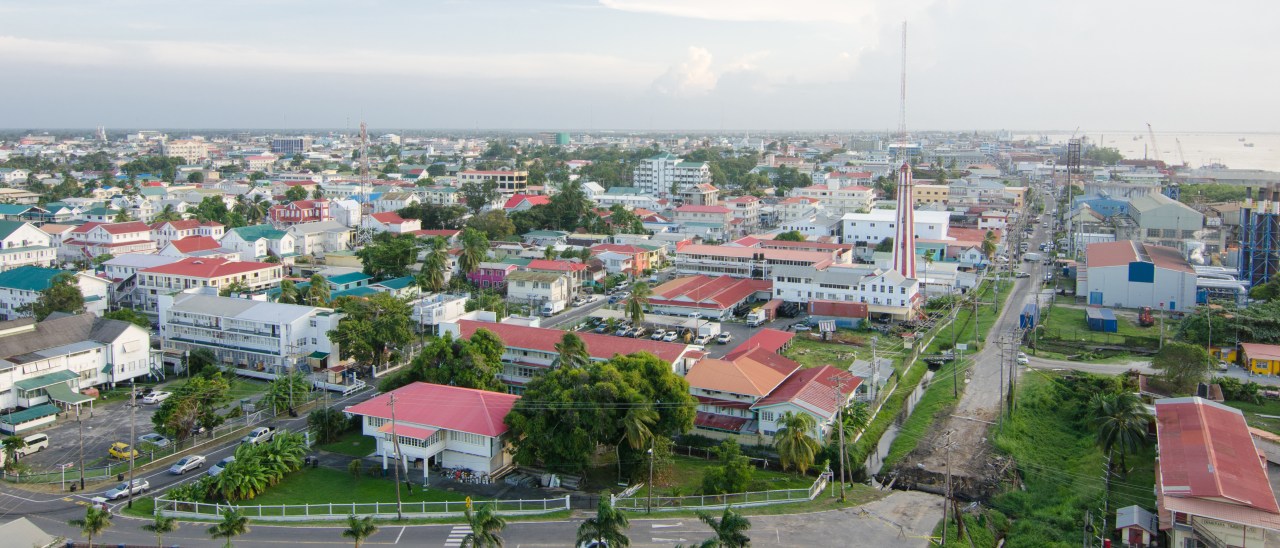

I discuss this one night with Meshach Pierre, a young biologist and wildlife photographer. “Guyana suffers from brain drain, especially among intellectual people,” who often leave for opportunities abroad, he tells me; the country has one of the highest emigration rates in the world. Like many Guyanese I met, Pierre has family in Queens—“feels like there are more Guyanese there than in Guyana”—and a grandmother in Toronto.
Pierre recently returned from an expedition to Mount Ayanganna with the Smithsonian Institution. He is on crutches, the result of a badly sprained ankle, a field hockey injury. Although he’s worried about his own postgrad well-being, he’s proud of his country, and had no imminent plans to leave. “Younger people are increasingly thinking we should stay behind, commit intellectual and academic and business resources to [this] country,” he says. “If we keep leaving because there’s nothing for us here, we only ensure the perpetuation of that.”
Guyana’s interior is rich with resources, including gold, timber, sugar, and bauxite. It’s invariably described as vast and untapped, which is one obvious path to economic development. (Mining is Guyana’s number one industry.) But the interior is “almost entirely inaccessible,” Pierre says, “which gets at a problem with scientific research in Guyana, or any largely untouched area—data is scarce.” Because the interior is so difficult to regulate, a black market has sprung up for gold, wildlife, Venezuelan cocaine, and more.
The tension between the beauty of the land and its vulnerability to plunder has been part of the Caribbean story ever since Europeans landed here. “Guiana is a country that hath yet her maidenhead,” wrote Sir Walter Raleigh, in his 1596 account “The Discoverie of Guiana,” the first book published about the country. Raleigh had sailed up the Orinoco River with around 100 men in five boats, in search of El Dorado. He never found it, of course.
I see two bird races in Guyana. At both, I was surprised at how little seemed to happen; if you don’t know what to look for, it would be hard to tell that anything was going on at all.
I’d preconceived of the races as grandly competitive affairs, a showcase of drama and high stakes, befitting the paths by which a wild oryzoborus angolensis becomes a caged towa towa. But the races are mostly a social experience; the guys are there to show off their birds, or buy seed, or catch up. It has the same purpose served by any club in the world; the details are geographically and culturally particular.
On my last day in the country, I meet with Cecil Bess. “Mr. Bess has some of the best birds in the country,” says the driver who took me to meet him.
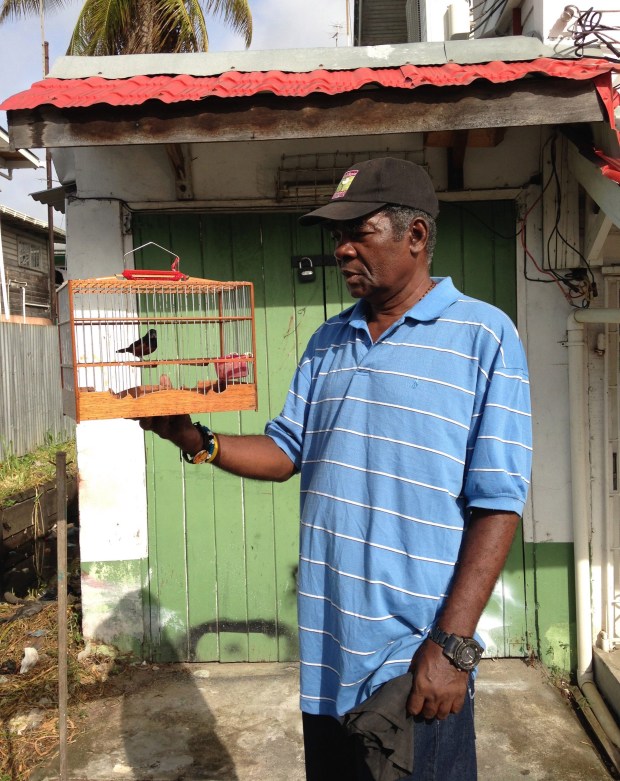
Bess’ house is near the center of the city. There’s a race on his street every Sunday, which he watches from his porch like a wizened veteran. He says “Good morning, sister” to every woman who walks by. He has been bird-minding for over 60 years, and his birds are of such renowned quality that he can no longer walk them out himself, because thieves will try to steal them.
“In order to train them well, you have to love them,” Bess says. He’s wearing a black baseball cap pulled low over bushy eyebrows. “You have to take care of them, look after them well, see what they like, what they don’t like.”
The apricot sunrise sends wide wedges of light arrowing over the dusty streets and wooden houses. Perhaps a dozen men mingle in the roadside, showing off their birds, discussing tactics, shooting the shit. The races contain little drama and less stakes; they are like heats in advance of some main event that never comes.
Between dispensing advice to novice bird minders—when to walk out the birds, what to feed them when their feces is gray (a tonic called “bird pepper”), how to see them through their molting phase—Bess tells me stories to illustrate how a bird can break your heart. He recounts the sad tale of Lion Man, “a big, strong, hefty guy,” Bess says.
“He had a bird named Romell. It was what you call a bad bird—it whistle plenty. Another guy, named Mac, was after Romell, and offered two birds for him in a trade. Lion Man, in the weakness of the moment, said yes. About an hour after he go home, he realized he make a mistake. He went back to Mac, but Mac was hiding Romell somewhere. Later he sent him away.
“About a month passed. Lion Man, he realized he can’t get back Romell, and believe you me, the man go home and pass away. People die for the love of a bird.”
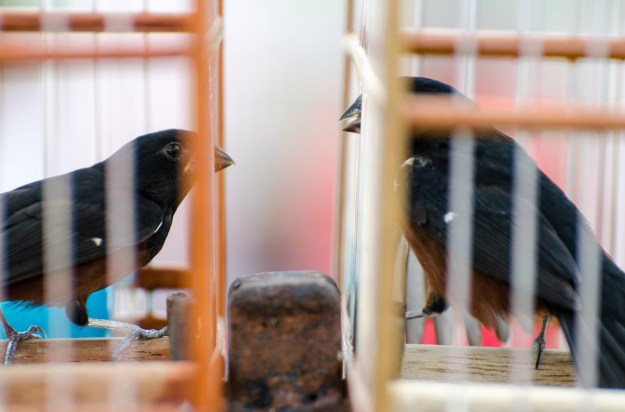
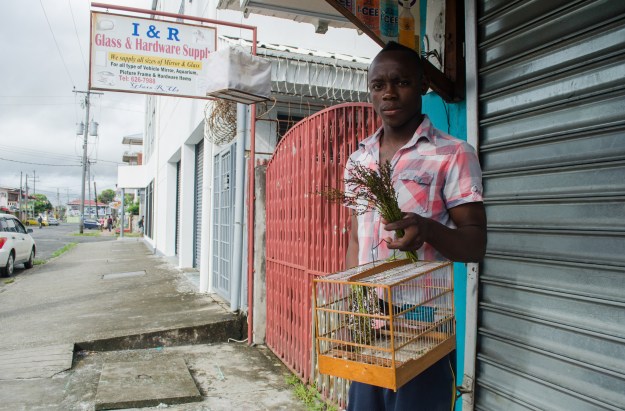
In Queens, a few blocks from Smokey Oval Park, stands Cameo Pet Shop. It’s a gently foreboding place, low-lit, long, and quiet; the only sounds are the amniotic gurgle of aquariums and the soft chirps from the birdcages lining the walls. The cages are filled with dozens of exotic, tropical species—neon green and electric-blue parakeets, sunshine-yellow cockatiels, spangled Atlantic canaries—some nearly a foot tall, others small enough to slip into your pocket.
The birdsongs sound random yet musical, their wild euphony ringing in stark contrast to all of the noise outside—the honking of cars, the wail of sirens, the clanging of the trains on the elevated tracks. At the far end of the shop, Steve Gruebel, the owner, is feeding torn-off pieces of cabbage to an iguana. He has become acquainted with several of the bird minders when they have come in to purchase seed for their finches.
The seed finches, Gruebel says, are like many of the birds for sale at Cameo Pet Shop. “They’re songbirds. They’re born with their song, and it’s theirs alone. No two are the same. But they don’t have the long, beautiful songs of some of these other birds,” he says, indicating a row of canaries behind the counter. He shakes his head.
“Some of those finches, they’ll sell ’em for thousands. I don’t see the difference—all they do is peep.”
Originally published on Roads & Kingdoms on May 18, 2017.